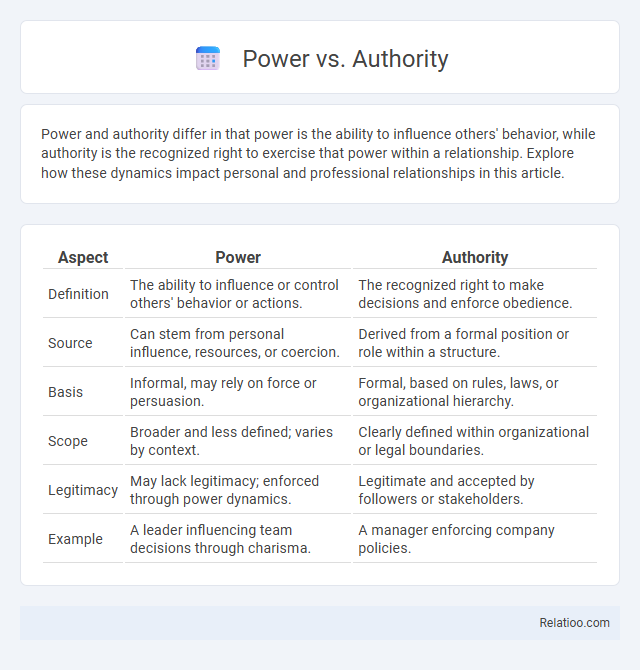Power and authority differ in that power is the ability to influence others' behavior, while authority is the recognized right to exercise that power within a relationship. Explore how these dynamics impact personal and professional relationships in this article.
Table of Comparison
| Aspect | Power | Authority |
|---|---|---|
| Definition | The ability to influence or control others' behavior or actions. | The recognized right to make decisions and enforce obedience. |
| Source | Can stem from personal influence, resources, or coercion. | Derived from a formal position or role within a structure. |
| Basis | Informal, may rely on force or persuasion. | Formal, based on rules, laws, or organizational hierarchy. |
| Scope | Broader and less defined; varies by context. | Clearly defined within organizational or legal boundaries. |
| Legitimacy | May lack legitimacy; enforced through power dynamics. | Legitimate and accepted by followers or stakeholders. |
| Example | A leader influencing team decisions through charisma. | A manager enforcing company policies. |
Defining Power and Authority
Power is the capacity to influence or control the behavior of others, often derived from resources, skills, or social status, whereas authority is the recognized and legitimate right to make decisions and enforce rules within an organization or society. Your ability to exercise power depends on the recognition and acceptance of authority, which provides a formal framework for decision-making and compliance. Threat, in contrast, operates through fear and coercion rather than legitimacy or influence.
Key Differences Between Power and Authority
Power refers to the ability to influence or control the behavior of others, often derived from various sources such as expertise, charisma, or coercion, while authority is the legitimate right granted to an individual or organization to make decisions and enforce rules. The key difference lies in legitimacy; authority is formally recognized and sanctioned within a specific framework, whereas power can exist without official sanction and may rely on fear or persuasion. Understanding these distinctions helps you navigate social and organizational dynamics by recognizing when influence comes from accepted rules or from personal or positional strength.
Sources of Power in Organizations
Power in organizations stems from various sources including legitimate authority, expertise, control over resources, and the ability to influence others through rewards or sanctions. Authority derives from formal roles and organizational structure, granting individuals the right to make decisions and command compliance. Threat-based power relies on the capability to impose penalties or negative consequences, influencing behavior through fear rather than respect or cooperation, which can impact Your effectiveness in leadership if used excessively.
Types of Authority Explained
Types of authority include traditional, charismatic, and legal-rational, each defining how power is legitimized and exercised within organizations or societies. Traditional authority stems from established customs and inherited power, while charismatic authority relies on personal charm and leadership qualities. Legal-rational authority, often seen in modern institutions, is based on formal rules and procedures that shape Your interactions with systems and structures.
The Role of Legitimacy in Authority
Legitimacy is the foundational element that differentiates authority from mere power or threat, ensuring compliance through recognized and accepted rules or norms. Authority derives its strength from legitimacy, which grants individuals or institutions the right to enforce decisions, making their power stable and sustainable. In contrast, power exercised without legitimacy often relies on threats or coercion, resulting in resistance and instability.
How Power is Exercised
Power is exercised through the ability to influence or control the behavior of others, often relying on resources such as skills, knowledge, or social position. Authority derives its exercise from recognized and legitimate rights granted by organizational or societal structures, enabling individuals to command compliance. Threats leverage the potential for punishment or negative consequences to enforce obedience when authority or power alone may be insufficient.
Influence of Authority on Decision-Making
Authority significantly shapes decision-making by establishing legitimate power that commands compliance and guides behavior within organizations. Unlike mere power, authority is rooted in formal roles and recognized structures, which enhances its influence on choices and policy implementation. Threats may coerce compliance temporarily, but authority fosters sustained commitment by aligning decisions with institutional norms and expectations.
Power Without Authority: Risks and Consequences
Power without authority can lead to confusion and conflict within organizations, as individuals may assert influence without legitimate support or recognition. Your ability to effectively lead is compromised when power is exercised without formal authority, resulting in resistance, diminished trust, and potential sabotage from others. Operating solely through power rather than authority undermines team cohesion and threatens long-term organizational stability.
Balancing Power and Authority in Leadership
Effective leadership requires a delicate balance between power, authority, and the strategic use of threat to maintain control and inspire respect. Power represents the capability to influence others, while authority is the legitimate right to make decisions and command compliance within a defined structure. Balancing these elements ensures that leaders exercise influence without coercion, fostering trust and sustainable motivation rather than relying solely on the fear induced by threats.
Real-World Examples: Power vs. Authority
Power often derives from control over resources or influence, exemplified by a CEO who can unilaterally decide company direction regardless of formal hierarchy. Authority is institutionalized and legitimized, such as a judge enforcing laws within a courtroom based on legal mandate. In contrast, power without authority, like a union leader mobilizing workers, relies on influence rather than sanctioned control.

Infographic: Power vs Authority
 relatioo.com
relatioo.com